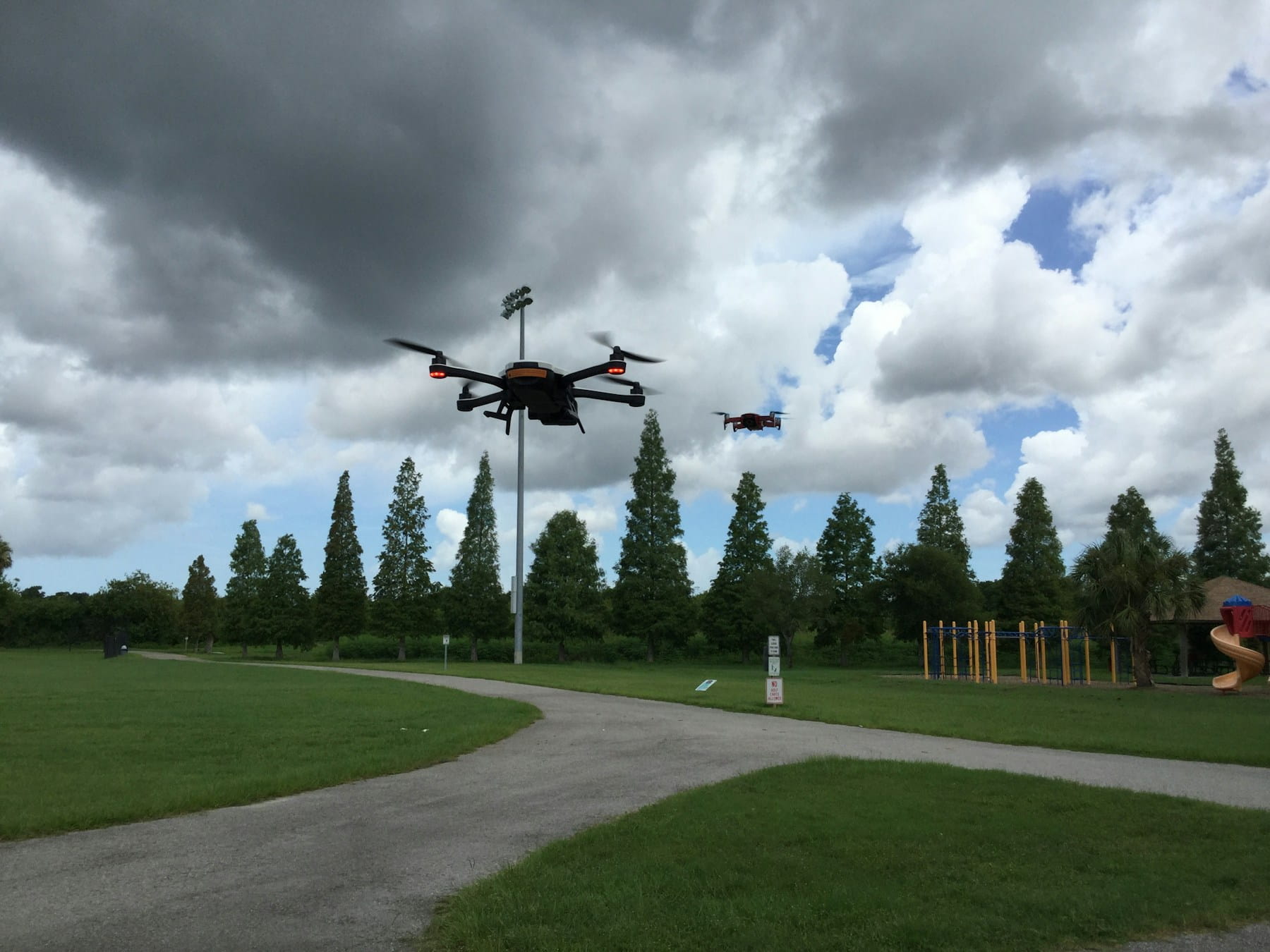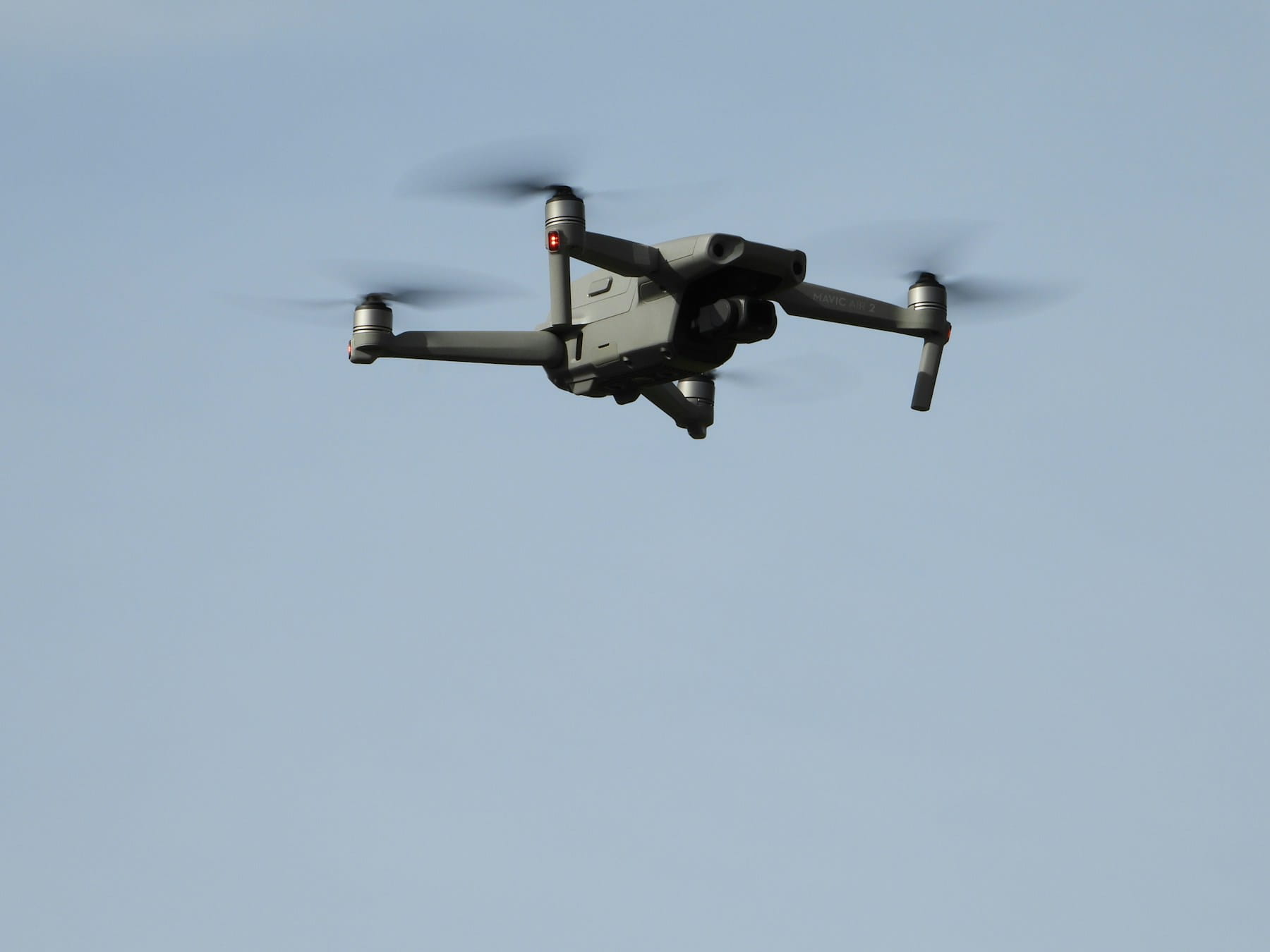Learn how to scale a drone business by building operational systems, developing specialized services, optimizing marketing, and managing finances for sustainable growth and competitive advantage.
The moment arrives when every drone operator realizes the painful truth: there's only one of them. Sure, handling three real estate shoots per week feels manageable. But when construction companies start calling for weekly progress monitoring and agricultural clients need monthly field surveys, the math stops working. Your flight schedule becomes a jigsaw puzzle that never fits together properly.
Scaling a drone business means shifting from being the person who flies every mission to becoming the architect of operations. This transformation requires more than just buying additional aircraft or posting job listings. Smart operators build systems that work independently, develop specialized expertise that commands premium rates, and create predictable revenue streams.
Most drone businesses plateau because owners cling to the pilot's seat instead of stepping into the CEO role. The successful ones recognize that growth happens when operations can function smoothly without their constant involvement. This shift creates capacity for bigger contracts while maintaining service quality.
Table of contents
- Foundation building for growth
- Operational systems and team development
- Service specialization strategies
- Marketing and sales optimization
- Technology and compliance advancement
- Financial management for scaling
- Common scaling challenges and solutions
- Implementation considerations
Foundation building for growth
The difference between a hobby that pays and a business that scales lies in the foundation. Strong foundations support weight. Weak ones crumble under pressure.
Identifying profitable service lines
Not all drone services generate equal returns. Some require minimal equipment investment and deliver healthy margins. Others demand expensive sensors but unlock premium pricing in specialized markets. The key lies in understanding which services align with your market position and growth goals.
Profitable service identification starts with honest financial analysis. Calculate the true cost of delivering each service type, including equipment depreciation, travel time, data processing hours, and client communication. Many operators discover that their lowest-priced services consume disproportionate resources while their premium offerings generate better returns with less hassle.
Construction progress monitoring exemplifies a high-value service. Projects span months or years, creating recurring revenue opportunities. Clients understand the ROI of preventing costly rework through regular aerial documentation. Applications like construction site monitoring and detailed construction inspections command premium rates. The same equipment used for real estate photography can capture construction progress, but the pricing model shifts from per-flight to monthly retainer structures.
Agricultural services represent another growth opportunity. Crop health analysis using multispectral sensors provides farmers with actionable data that directly impacts yield optimization. The initial sensor investment may seem steep, but agricultural clients often commit to seasonal monitoring contracts worth thousands of dollars.
Market positioning and differentiation
Generic positioning kills profit margins. When clients view drone services as commoditized offerings, they make decisions based solely on price. Differentiation creates value perception that justifies premium pricing.
Technical expertise forms the foundation of strong positioning. Operators who understand photogrammetry principles deliver more accurate mapping results. Those familiar with thermal imaging applications provide better building envelope assessments. This knowledge gap separates professionals from hobbyists in client perception.
Industry specialization amplifies differentiation. A drone operator who speaks construction terminology and understands project timelines becomes invaluable to general contractors. One who knows agricultural terminology and planting cycles develops stronger relationships with farming operations. This specialized knowledge commands respect and higher rates.
Geographic focus can also create competitive advantages. Becoming the go-to drone operator in a specific region builds reputation through word-of-mouth marketing. Local operators often win contracts over distant competitors due to travel cost considerations and familiarity with area conditions.
Readiness assessment framework
Scaling requires honest self-evaluation. Many operators rush into growth before establishing proper foundations, creating operational chaos that damages client relationships and financial stability.
The following framework helps assess scaling readiness across multiple dimensions:
| Assessment Area | Strong Foundation | Needs Development |
|---|---|---|
| Financial Health | Consistent profitability, 3-6 months operating expenses in reserve | Irregular income, limited cash reserves |
| Operational Systems | Documented procedures, quality control processes | Ad-hoc operations, inconsistent delivery |
| Market Position | Established reputation in specific niche | Generic service provider |
| Client Base | Recurring clients, referral sources | Project-by-project relationships |
| Personal Capacity | Working on business strategy | Overwhelmed with daily operations |
Operators who score "Strong Foundation" in most areas can consider aggressive growth strategies. Those with mixed results should focus on strengthening weak areas before pursuing expansion. This honest assessment prevents costly mistakes during the scaling process.
Operational systems and team development
Growth breaks informal processes. What works for a solo operator fails when managing multiple pilots across various projects. Operational systems provide the structure needed to maintain quality while increasing capacity.
Standardizing operational procedures
Standard Operating Procedures (SOPs) transform tribal knowledge into transferable processes. These documents ensure consistent service delivery regardless of which pilot executes the mission. Well-written SOPs reduce training time for new hires while maintaining safety and quality standards.
Effective SOPs cover every aspect of operations. Pre-flight procedures detail equipment checks, weather assessment, and site survey requirements. Flight execution standards specify data capture patterns, altitude parameters, and safety protocols. Post-flight processes outline data management, quality control, and client delivery procedures.
Documentation should be specific enough to guide inexperienced operators but flexible enough to accommodate varying conditions. For example, mapping SOPs might specify 80% image overlap for standard terrain but allow adjustment to 90% overlap for challenging topography. This flexibility prevents rigid adherence to procedures that may not fit every situation.
Regular SOP updates maintain relevance as operations evolve. Equipment changes, regulatory updates, and lessons learned from field experience should be incorporated into procedure documents. Annual reviews ensure that SOPs remain current and useful.
Building a skilled team
Hiring decisions shape company culture and operational capacity. The wrong hire can damage client relationships and create operational headaches. The right person becomes a force multiplier who increases capacity while maintaining standards.
Technical skills form the baseline requirement. Pilots need appropriate certifications and demonstrated competency with relevant equipment. Comprehensive pilot training programs ensure team members meet professional standards. But technical ability alone doesn't guarantee success. Communication skills, problem-solving ability, and professional demeanor often matter more than stick-and-rudder proficiency. Tracking pilot flight hours helps ensure experience requirements are met.
Client-facing roles require particular attention to soft skills. The pilot who represents your company on construction sites must communicate effectively with project managers, adapt to changing conditions, and maintain professionalism under pressure. These qualities can't be taught easily but can be assessed during the hiring process.
Training programs accelerate new hire integration. Structured onboarding introduces company procedures, safety protocols, and client expectations. Mentorship programs pair experienced operators with new hires to transfer practical knowledge that doesn't appear in written procedures.
Compensation structures should align with business goals. Base salary plus performance bonuses motivate quality work while controlling labor costs. Profit-sharing arrangements give team members stake in company success. Professional development opportunities help retain talented individuals who might otherwise seek advancement elsewhere.
Quality control implementation
Scaling increases quality control complexity. Manual review processes that work for small operations become bottlenecks as volume increases. Systematic approaches maintain standards while accommodating growth.
Automated quality checks catch common issues before manual review. Flight planning software can verify coverage requirements and identify potential gaps. Image processing workflows can flag blurry photos or insufficient overlap. These automated systems handle routine quality assurance, allowing human reviewers to focus on complex issues.
Client feedback mechanisms provide external quality validation. Post-project surveys capture satisfaction levels and identify improvement opportunities. Regular check-ins during long-term engagements ensure that service delivery meets expectations. This feedback drives continuous improvement and identifies training needs.
Performance metrics track quality trends over time. Revision rates, client complaints, and repeat business percentages indicate whether quality standards are being maintained during growth periods. Regular metric reviews help identify problems before they become systemic issues.
Service specialization strategies
Generalists compete on price. Specialists command premium rates. The path to profitable scaling runs through service specialization that creates unique value propositions.
Niche market development
Successful specialization begins with market research. Identifying underserved niches with strong growth potential positions businesses for sustainable expansion. The key lies in finding markets where drone technology provides clear ROI for clients.
Emergency response represents an emerging specialization opportunity. Fire departments, search and rescue teams, and disaster response organizations increasingly use drones for situational awareness and personnel safety. These applications require specialized equipment like thermal cameras and extended flight time capabilities, but they also command higher rates due to their critical nature.
Infrastructure inspection offers another specialization path. Power companies, telecommunications providers, and transportation authorities need regular asset assessments. Specialized applications like cell tower inspections, power line inspections, and wind turbine inspections demonstrate the breadth of opportunities. Drones provide safer, more cost-effective inspection methods compared to traditional approaches. The technical knowledge required creates barriers to entry that protect profit margins.
Environmental monitoring services address growing regulatory compliance needs. Companies in extractive industries, manufacturing, and agriculture face increasing environmental oversight. Applications like forestry inspections and site security monitoring expand service possibilities. Drone-based monitoring provides documentation required for permit compliance while reducing manual inspection costs.
Advanced service offerings
Basic aerial photography and videography services face commoditization pressure. Advanced offerings that require specialized knowledge and equipment maintain higher profit margins while reducing competition.
Photogrammetry services transform aerial images into precise measurements and 3D models. Construction companies use these outputs for progress monitoring, volume calculations, and as-built documentation. Surveying applications leverage photogrammetry for accurate site measurements. The technical expertise required to deliver accurate photogrammetric products creates significant barriers to entry.
LiDAR mapping provides precise topographic data for engineering and surveying applications. The equipment investment is substantial, but clients pay premium rates for the accuracy and detail that LiDAR provides. Specialized software knowledge and data processing skills further differentiate these services.
Thermal imaging applications span multiple industries. Building envelope analysis helps identify energy efficiency improvements. Electrical system inspections detect potential failures before they occur. Agricultural applications monitor crop stress and irrigation effectiveness. Comprehensive asset inspection services integrate thermal and visual data for detailed assessments. Each application requires specific knowledge and interpretation skills.
Service packaging strategies
Packaging related services into comprehensive solutions increases project values while reducing client acquisition costs. Rather than selling individual flights, successful operators sell outcomes that address client business needs.
Construction monitoring packages might include weekly progress photography, monthly orthomosaic maps, and quarterly 3D models. This comprehensive approach provides clients with complete project documentation while creating predictable revenue streams for operators.
Agricultural monitoring packages could combine crop health analysis, irrigation effectiveness assessment, and yield prediction services. Farmers receive actionable insights throughout the growing season while operators secure seasonal contracts worth thousands of dollars.
Emergency preparedness packages might include risk assessment mapping, evacuation route planning, and incident response protocols. These services help organizations prepare for potential disasters while creating ongoing relationships beyond individual incident responses.
Marketing and sales optimization
Organic growth through referrals works initially. Sustainable scaling requires systematic marketing and sales processes that generate predictable leads and convert prospects into clients.
Digital presence development
Professional online presence forms the foundation of modern marketing strategies. Potential clients research service providers online before making contact. A well-designed website with compelling case studies and clear service descriptions influences purchasing decisions.
Portfolio presentation should focus on results rather than just pretty pictures. Case studies that explain client challenges, solution approaches, and measurable outcomes demonstrate value more effectively than galleries of aerial photos. Quantified results – time saved, costs reduced, problems prevented – resonate with business decision-makers.
Search engine optimization increases visibility for relevant searches. Local SEO tactics help drone businesses appear when prospects search for services in specific geographic areas. Technical SEO ensures that websites load quickly and function properly on mobile devices.
Content marketing establishes expertise while attracting potential clients. Blog posts that address common industry challenges, explain technical concepts, or share project insights demonstrate knowledge while improving search rankings. This approach builds trust before prospects make contact.
Relationship building tactics
Systematic relationship building creates sustainable lead generation that doesn't depend on paid advertising. Professional networks, industry associations, and strategic partnerships provide access to decision-makers who purchase drone services.
Industry event participation provides face-to-face networking opportunities. Trade shows, conferences, and professional meetings allow drone operators to meet potential clients and demonstrate expertise through presentations or booth displays. These events also provide intelligence about industry trends and competitor activities.
Strategic partnerships with complementary service providers create referral opportunities. Engineering firms, construction companies, and consulting organizations often have clients who need drone services. Formal referral relationships with these partners create steady lead flow.
Professional association membership demonstrates commitment to industry standards and continuous learning. Many clients prefer working with operators who participate in professional development and maintain current certifications.
Sales process systematization
Informal sales processes limit growth potential. Systematic approaches improve conversion rates while reducing the time required to close new business. Standardized processes also enable delegation as teams grow.
Lead qualification procedures prevent wasting time on prospects who aren't ready to buy. Qualification criteria might include project budget, timeline, and decision-making authority. Early qualification conversations save time for both operators and prospects.
Proposal templates speed response times while ensuring consistency. Well-designed templates include standard terms and conditions, scope definitions, and pricing structures. Customization focuses on specific client needs rather than recreating entire proposals.
Follow-up systems prevent leads from falling through communication gaps. Customer relationship management (CRM) systems track interaction history and automate follow-up reminders. Systematic follow-up often makes the difference between winning and losing projects.
Technology and compliance advancement
Technology advancement enables new service offerings while regulatory compliance protects business operations. Smart operators stay ahead of both curves to maintain competitive advantages.
Equipment investment strategies
Equipment decisions significantly impact both capabilities and cash flow. Strategic investments enable premium services while poor choices tie up capital without generating returns. Smart operators align equipment purchases with specific market opportunities.
Modular systems provide flexibility while controlling costs. Drone platforms that accept multiple payloads enable diverse service offerings without purchasing separate aircraft for each application. This approach reduces equipment investment while maximizing utilization.
Lease versus purchase decisions depend on usage patterns and financial capacity. High-utilization equipment often justifies purchase due to lower long-term costs. Specialized sensors used occasionally might make more sense to lease or rent as needed.
Technology refresh cycles should align with business depreciation schedules. Planning equipment upgrades allows operators to maintain competitive capabilities while managing cash flow impacts. Scheduled replacements prevent unexpected equipment failures that could disrupt operations.
Regulatory navigation
Regulatory compliance becomes more complex as operations scale. Multiple pilots, diverse aircraft, and varying operational requirements create compliance challenges that small operations don't face. Implementing comprehensive compliance management systems ensures regulatory obligations are met consistently.
Advanced operational approvals unlock new service opportunities. Beyond Visual Line of Sight (BVLOS) waivers enable long-distance inspections and large-area mapping. Night operation approvals allow emergency response and infrastructure monitoring outside daylight hours. Understanding airspace requirements and VLOS limitations helps operators plan appropriate service offerings. These approvals require comprehensive safety documentation but create competitive advantages.
Safety Management Systems (SMS) provide frameworks for managing operational risks systematically. These systems identify hazards, assess risks, and implement mitigation measures. Risk assessment procedures and SORA frameworks support systematic safety management. Formal SMS implementation demonstrates professionalism to clients while reducing liability exposure.
International operations require understanding foreign regulations. Many countries have specific requirements for foreign operators or temporary flight permissions. Proper preparation prevents operational delays and potential legal issues.
Software integration
Software systems become critical as operations grow beyond manual tracking capabilities. Integrated platforms reduce administrative overhead while improving operational visibility and client communication. Fleet management systems coordinate multiple aircraft and pilots efficiently.
Flight planning software streamlines mission preparation while ensuring compliance with operational requirements. Mission planning workflows benefit from integrated tools that reduce preparation time. Advanced platforms integrate weather data, airspace information, and equipment capabilities to optimize flight parameters. Automated planning reduces preparation time while improving consistency.
Data management systems handle the increasing volume of information generated by expanding operations. Cloud-based platforms provide secure storage while enabling team access from multiple locations. Flight data monitoring provides operational insights for continuous improvement. Automated backup systems protect against data loss that could devastate client relationships.
DroneBundle provides comprehensive operations management capabilities that support business growth. The platform integrates flight planning, regulatory compliance, and project management functions into a single interface. This integration reduces administrative overhead while improving operational oversight and client communication. Try DroneBundle for streamlined operations management.
Financial management for scaling
Cash flow challenges kill more growing businesses than competition. Smart financial management provides the stability needed to invest in growth while maintaining operational flexibility.
Pricing strategies for growth
Pricing decisions affect both profitability and market positioning. Underpricing limits growth capital while overpricing reduces market opportunities. Strategic pricing balances these considerations while supporting scaling objectives.
Value-based pricing aligns rates with client outcomes rather than operator inputs. Clients who save thousands through drone-enabled efficiency improvements will pay premium rates for those results. This approach requires understanding client economics and demonstrating clear ROI.
Project-based pricing often generates higher revenues than hourly billing. Comprehensive service packages address complete client needs while creating larger individual transactions. This approach also provides more predictable revenue streams for planning purposes.
Retainer relationships provide stable cash flow that supports growth investments. Monthly or quarterly retainers guarantee minimum revenue levels while giving clients priority access to services. These arrangements work particularly well for ongoing monitoring or inspection services.
Cash flow optimization
Growth requires cash for equipment purchases, hiring, and operational expansion. Poor cash flow management can force profitable businesses into bankruptcy during expansion phases.
Payment terms significantly impact cash flow. Requiring deposits for large projects improves cash flow while demonstrating client commitment. Progress payments during long projects prevent cash flow gaps. Quick payment discounts encourage faster collection while reducing administrative costs.
Accounts receivable management becomes critical as client numbers grow. Systematic invoicing, payment tracking, and collection procedures prevent cash flow problems from outstanding receivables. Clear payment terms and consistent enforcement reduce collection issues.
Working capital management requires balancing growth investments with operational needs. Maintaining adequate cash reserves prevents operational disruptions during slow periods or unexpected expenses. Credit lines provide backup liquidity for growth opportunities.
Investment decision frameworks
Growth opportunities require capital allocation decisions. Smart operators evaluate investments based on their contribution to long-term business objectives rather than just immediate returns.
Return on investment calculations should include indirect benefits beyond direct revenue generation. Equipment that enables new service offerings might have lower immediate returns but higher long-term value. Training investments that improve efficiency or safety might not show direct ROI but provide competitive advantages.
Risk assessment becomes more important as investment amounts increase. Diversification across multiple market segments reduces dependence on any single client or industry. Geographic diversification can provide similar risk reduction benefits.
Financial projections guide investment timing and amounts. Conservative projections prevent overcommitment while optimistic scenarios identify growth potential. Scenario planning helps prepare for various outcomes and their financial implications.
Common scaling challenges and solutions
Every growing drone business faces similar challenges. Understanding these common issues and their solutions helps operators prepare for inevitable growing pains.
Team management issues
Managing remote teams creates unique challenges for drone operators. Pilots work independently at client sites, making direct supervision difficult. Communication systems and performance metrics become critical for maintaining standards.
Quality control systems must work without constant supervision. Standardized procedures, automated checks, and regular performance reviews help maintain standards across distributed teams. Implementing pre-flight checklists ensures consistent preparation across all team members. Client feedback provides external validation of service quality.
Scheduling coordination becomes complex with multiple pilots and projects. Centralized scheduling systems prevent conflicts while optimizing resource utilization. Buffer time in schedules accommodates weather delays and equipment issues. Understanding flight time limitations helps optimize scheduling efficiency.
Performance management requires clear expectations and regular feedback. Individual performance metrics should align with business objectives while being achievable with proper effort. Regular one-on-one meetings provide coaching opportunities and identify potential issues early.
Client acquisition bottlenecks
Successful operators often become victims of their own success. High-quality work generates referrals faster than capacity can grow. Managing this transition requires systematic approaches to client selection and capacity planning.
Client qualification becomes more important as demand exceeds capacity. Focusing on high-value clients who provide better profit margins and payment terms improves overall business health. This selectivity also reduces operational stress.
Pipeline management helps balance current projects with future opportunities. CRM systems track prospect progress through sales cycles while identifying potential bottlenecks. This visibility enables proactive capacity planning and resource allocation.
Capacity planning should consider both equipment and personnel limitations. Growth strategies might focus on expanding teams, increasing equipment utilization, or raising prices to manage demand. Each approach has different implementation timelines and capital requirements.
Technology integration problems
Rapid technology adoption can create integration challenges. New software systems, equipment platforms, and data processing workflows must work together seamlessly. Poor integration creates inefficiencies that offset technology benefits.
Change management processes help teams adapt to new systems and procedures. Training programs, documentation updates, and transition support reduce resistance while improving adoption rates. Gradual implementation often works better than sudden changes.
Data integration becomes critical as multiple systems generate information. APIs and data export capabilities enable information sharing between platforms. Manual data entry between systems creates bottlenecks and error opportunities.
Vendor relationships affect long-term technology strategies. Working with responsive vendors who provide good support reduces operational risks. Diversifying across multiple vendors prevents dependence on any single supplier.
Implementation Considerations
Business growth transforms drone operations from personal ventures into scalable enterprises. This transformation requires strategic thinking, systematic implementation, and persistent execution across multiple business dimensions.
Organizations implementing scaling strategies benefit from understanding equipment capabilities, team dynamics, and market opportunities before committing to aggressive expansion. Successful implementations typically start with strong compliance foundations, systematic maintenance protocols, and comprehensive pilot training programs.
In Summary
Mastering drone business scaling demands strategic planning, operational discipline, and systematic execution. From building strong foundations and developing specialized services to optimizing marketing and managing finances, comprehensive scaling strategies create sustainable competitive advantages.
The complexity of professional scaling requires attention to multiple factors including team development, technology integration, regulatory compliance, and financial management. As the industry matures and competition increases, operators who master these fundamentals position themselves for sustained market leadership.
Organizations implementing systematic scaling procedures today are establishing operational frameworks that support long-term growth while maintaining quality standards. The integration of professional management systems with specialized service expertise creates the foundation for market dominance in commercial drone operations.
Ready to Scale Your Drone Operations?
Join commercial operators who have accelerated their growth through comprehensive operational systems and management tools. Whether you're expanding into new markets, building teams, or optimizing existing operations, systematic foundations enable sustainable scaling and competitive advantage.
Start your free trial today — no credit card required. Or book a demo to see how DroneBundle integrates fleet management, compliance tracking, maintenance protocols, and pilot training records in a platform designed specifically for scaling commercial drone operations.




